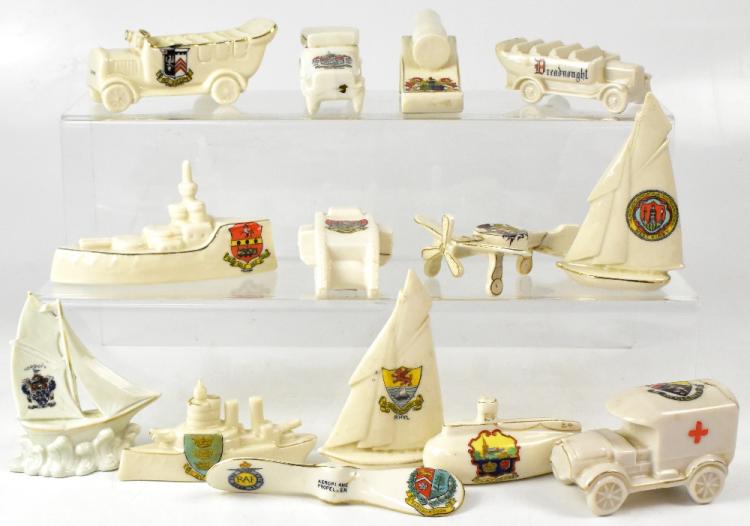The Dreadnought: a rare engraved Privateer wine glass, circa 1757-58The bucket bowl engraved with the three-masted ship in sail, inscribed 'Success to the DREADNOUGHT Privateer,' below the rim, on a single-series opaque twist stem containing a multi-ply corkscrew edged with a pair of heavy opaque white threads, over a conical foot, the stem repaired with a silver sleeve, 15.5cm highFootnotesProvenance Peter Lazarus Collection Terence C Woodfield Collection Chris Crabtree Collection Literature Cleo Witt, Introducing Bristol Glass (1984), p.29 Cleo Witt, Cyril Weeden and Arlene Palmer Schwind, Bristol Glass (1984), p.42 Exhibited The Bristol and West Building, Broad Quay, June-July 1984 The Dreadnought was a Bristol ship of 130 tons with 12 guns, 12 swivels and a crew of 120 men, owned by Bristol merchants John Harbord, Jonah Thomas, Samuel Thomas and William Wasbrough. She was first declared on 22 March 1757 by Captain James Leisman, on 16 March 1758 by Captain Richard Fitzherbert, on 29 August that year by Captain Joseph English, then again on 10 April 1762 by Captain George Burford, see J W Damer Powell, Bristol Privateers and Ships of War (1930), pp.200-1. A diary written by the ship's unnamed surgeon during a four-month cruise in 1757 under the captaincy of Leisman in the Bristol Archives details life on board, including the capture of the Lyon, a French ship travelling from St. Domingo to Bordeaux. The dreadnought captured several foreign vessels. Perhaps her greatest success, as noted in Berrow's Worcester Journal in August 1757, was the capture of 'the Marquis de Conflans, from St. Domingo to Rochelle. She mounts 20 Guns, and engag'd the Dreadnought three Hours. This Prize is reckon'd worth between £20,000 and £30,000'. Lloyd's List describes this ship as being '300 Tons, 12 Guns and 30 Men, loaded with about 160 Hhds of fine, and 160 of brown Sugar, about 170 Hhds of Coffee, 12 Casks of Indigo, 4 Bags of Cotton, & a small Quantity of Tortoiseshell.' An identical glass, presumably from the same original set, is in the Fitzwilliam Museum in Cambridge (inv. no.C.523-1961), illustrated in the catalogue (1978), p.105, no.269a.
The Dreadnought: a rare engraved Privateer wine glass, circa 1757-58The bucket bowl engraved with the three-masted ship in sail, inscribed 'Success to the DREADNOUGHT Privateer,' below the rim, on a single-series opaque twist stem containing a multi-ply corkscrew edged with a pair of heavy opaque white threads, over a conical foot, the stem repaired with a silver sleeve, 15.5cm highFootnotesProvenance Peter Lazarus Collection Terence C Woodfield Collection Chris Crabtree Collection Literature Cleo Witt, Introducing Bristol Glass (1984), p.29 Cleo Witt, Cyril Weeden and Arlene Palmer Schwind, Bristol Glass (1984), p.42 Exhibited The Bristol and West Building, Broad Quay, June-July 1984 The Dreadnought was a Bristol ship of 130 tons with 12 guns, 12 swivels and a crew of 120 men, owned by Bristol merchants John Harbord, Jonah Thomas, Samuel Thomas and William Wasbrough. She was first declared on 22 March 1757 by Captain James Leisman, on 16 March 1758 by Captain Richard Fitzherbert, on 29 August that year by Captain Joseph English, then again on 10 April 1762 by Captain George Burford, see J W Damer Powell, Bristol Privateers and Ships of War (1930), pp.200-1. A diary written by the ship's unnamed surgeon during a four-month cruise in 1757 under the captaincy of Leisman in the Bristol Archives details life on board, including the capture of the Lyon, a French ship travelling from St. Domingo to Bordeaux. The dreadnought captured several foreign vessels. Perhaps her greatest success, as noted in Berrow's Worcester Journal in August 1757, was the capture of 'the Marquis de Conflans, from St. Domingo to Rochelle. She mounts 20 Guns, and engag'd the Dreadnought three Hours. This Prize is reckon'd worth between £20,000 and £30,000'. Lloyd's List describes this ship as being '300 Tons, 12 Guns and 30 Men, loaded with about 160 Hhds of fine, and 160 of brown Sugar, about 170 Hhds of Coffee, 12 Casks of Indigo, 4 Bags of Cotton, & a small Quantity of Tortoiseshell.' An identical glass, presumably from the same original set, is in the Fitzwilliam Museum in Cambridge (inv. no.C.523-1961), illustrated in the catalogue (1978), p.105, no.269a.











/107851/Internet%20Image%201.jpg)
/98333/Internet%20Image%201.jpg)
/70946/Internet%20Image%201.jpg)

Testen Sie LotSearch und seine Premium-Features 7 Tage - ohne Kosten!
Lassen Sie sich automatisch über neue Objekte in kommenden Auktionen benachrichtigen.
Suchauftrag anlegen